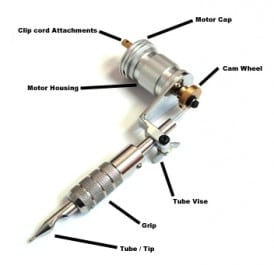Rotary machines have become a popular choice in recent years. A rotary tattoo machine differs vs a coil machine in that it is driven by a DC motor instead of electromagnetic coils. A lot of new artists tend to find the rotary to be easier to setup. A rotary will run smoother and quieter than a coil machine.
Pros and Cons to a Rotary Machine
There are pros and cons to a rotary machine. Parts on a rotary machine are usually less expensive to replace. In addition, there are fewer parts to replace. Rotary machines are plug and play, there is little to adjust. The only adjustments are the needle depth which is adjusted via the position of the tube grip. Many new artists tend to opt for rotary machines as they have as much of a learning curve compared to coil machines. On the other hand, although the parts cost less to maintain, they are also less durable than a coil machine.

Tuning a Rotary Tattoo Gun
The rotary gun is easy to tune. They are referred to as plug and play machines because they are literally that easy to start using. The main adjustments you will make are to the position of the tube grip to determine needle depth. It is best to start off with the same standard needle depth for coil machines. Needle depth of the thickness of a dime for lining and a nickel for shading. These depths are a starting point, other factors that may change your required needle depth include: Output voltage of power supply, thickness of clients skin and size of cam wheel.
Liner or Shader?
Most rotary machines can be used for lining and shading. The only part of a rotary machine that will increase performance in either duty is the cam. The cam can come in different sizes. The larger the cam, the longer the rotation and the slower the machine. The smaller the cam, the smaller the rotation and the faster the machine. A smaller cam would be more suited for lining. A larger cam would be more suited for shading.